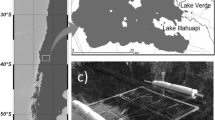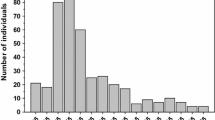Abstract
The effects of ultraviolet radiation (UVR), desiccation and conditions in tidal pools on embryonic survival were examined for two common pulmonate limpets that lay intertidal benthic egg masses on rocky shores in New Zealand: Benhamina obliquata and Siphonaria australis. Field surveys and manipulative experiments were conducted between December 2006 and September 2007 in the Wellington region of New Zealand (41°17′S, 174°47′E). Egg mass deposition sites in the field were species-specific: B. obliquata deposited eggs primarily in shaded crevices, whereas S. australis predominantly deposited egg masses in the sun and in tidal pools. For both species, however, embryonic mortality was greater in egg masses that had been in full sun compared to shade. For S. australis, there was also high mortality in egg masses in tidal pools or desiccated compared to those that remained submerged in flowing seawater at low tide. In outdoor experiments, embryonic mortality was also always greatest for egg masses exposed to full sun, and lowest for those in shaded treatments. Mortality was also higher if egg masses were in simulated tidal pools, and for S. australis, if desiccated, compared to those submerged in flowing seawater. Periods of particularly sunny conditions with high temperatures also resulted in higher overall mortality. Finally, egg masses of both species that were initially deposited in the shade had greater mortality in response to subsequent UV exposure compared to egg masses initially deposited in full sun. Results from this study suggest that the egg masses of these two species are highly vulnerable to UVR, as well as other intertidal stressors. Embryos of both of these species may be at risk of high mortality particularly during summer when extreme conditions of UV intensity and high temperature coincide with low tide cycles.




Similar content being viewed by others
References
Benkendorff K, Davis AR (2004) Gastropod egg mass deposition on a temperate wave exposed coastline in New South Wales, Australia: implications for intertidal conservation. Aquat Conserv 14:263–280. doi:https://doi.org/10.1002/aqc.604
Blaustein AR, Kiesecker JM (2002) Complexity in conservation: lessons from the global decline of amphibian populations. Ecol Lett 5:597–608. doi:https://doi.org/10.1046/j.1461-0248.2002.00352.x
Borland C (1950) Ecological studies of Benhamina obliquata (Sowerby) a basommatophorous pulmonate in Otago Harbour. T R Soc NZ 78:385–393
Chambers RJ, McQuaid CO (1994) Notes on the taxonomy, spawn and larval development of South African species of the intertidal limpet Siphonaria Gastropoda: Pulmonata. J Molluscan Stud 60:263–275. doi:https://doi.org/10.1093/mollus/60.3.263
Creese RG (1980) Reproductive cycles and fecundities of two species of Siphonaria (Mollusca: Pulmonata) in South-Eastern Australia. Aust J Mar Freshwater Res 31:37–47. doi:https://doi.org/10.1071/MF9800037
Epel D, Hemela K, Shick M, Patton C (1999) Development in the floating world: defences of eggs and embryos against damage from UVR. Am Zool 39:271–278
Feder ME, Satel SL, Gibbs AG (1982) Resistance of the shell membrane and mineral layer to diffusion of oxygen and water in flexible shelled eggs of the snapping turtle (Chelydra serpentina). Respir Physiol 49:279–291. doi:https://doi.org/10.1016/0034-5687(82)90117-7
Gies P, Roy C, Javorniczky J, Henderson S, Lemus-Deschamps L, Driscoll C (2004) Global solar UV index: Australian measurements, forecasts and comparison with the UK. Photochem Photobiol 79:32–39. doi:10.1562/0031-8655(2004)79<32:GSUIAM>2.0.CO;2
Helmuth B, Harley C, Halpin P, O’Donnell M, Hofmann GE, Blanchette CA (2002) Climate change and latitudinal patterns of intertidal thermal stress. Science 298:1015–1017. doi:https://doi.org/10.1126/science.1076814
Hader DP, Kumar HD, Smith RC, Worrest RC (2007) Effects of solar UV radiation on aquatic ecosystems and interactions with climate change. Photochem Photobiol Sci 6:267–285. doi:https://doi.org/10.1039/b700020k
Huff DD, Grad G, Williamson CE (2004) Environmental constraints on spawning depth of yellow perch: the roles of low temperature and high solar ultraviolet radiation. Trans Am Fish Soc 133:718–726. doi:https://doi.org/10.1577/T03-048.1
Jenkins BW (1981) Siphonaria funiculata Reeve (Siphonariidae, Pulmonata): a redescription making S. virgulata Hedley a geographical variant of S. funiculata. J Malacol Soc 5:1–15
Kaufmann WK, Paules RS (1996) DNA damage and cell cycle checkpoints. FASEB J 10:238–247
Knox GA (1955) The development of Kerguelenella stewartiana (Powell) (Gastropoda: Siphonariidae). Pac Sci 9:85–89
Lamare MD, Lesser MP, Barker MF, Barry TM, Schimanski KB (2004) Variation in sunscreen compounds (mycosporine-like amino acids) for marine species along a gradient of ultraviolet radiation transmission within Doubtful Sound NZ. N Zeal J Mar Fresh 38:775–793
Lesser MP, Kruse VA, Barry TM (2003) Exposure to ultraviolet radiation causes apoptosis in developing sea urchin embryos. J Exp Biol 206:4097–4103. doi:https://doi.org/10.1242/jeb.00621
McKenzie RL, Connor B, Bodeker G (1999) Increased summertime UV radiation in New (1709–1711) Zealand in response to ozone loss. Science 285:1709–1711
Metaxas A, Scheibling RE (1993) Community structure and organization of tidepools. Mar Ecol Prog Ser 98:187–198. doi:https://doi.org/10.3354/meps098187
Morton J, Miller M (1968) The New Zealand seashore. Collins, London
Przeslawski R (2004) A review of the effects of environmental stress on embryonic development within intertidal gastropod egg masses. Moll Res 24:43–63. doi:https://doi.org/10.1071/MR04001
Przeslawski R (2005a) Combined effects of solar radiation and desiccation on the mortality and development of encapsulated embryos of rocky shore gastropods. Mar Ecol Prog Ser 298:169–177. doi:https://doi.org/10.3354/meps298169
Przeslawski R (2005b) Chemical sunscreens in intertidal gastropod egg masses. Invertebr Reprod Dev 46:119–124
Przeslawski R, Davis AR (2007) Does spawning behavior minimize exposure to environmental stressors for encapsulated gastropod embryos on rocky shores? Mar Biol (Berl) 152:991–1002. doi:https://doi.org/10.1007/s00227-007-0748-3
Przeslawski R, Davis AR, Benkendorff K (2004) Effects of UV and visible lights on the development of encapsulated molluscan embryos. Mar Ecol Prog Ser 268:151–160. doi:https://doi.org/10.3354/meps268151
Przeslawski R, Davis AR, Benkendorff K (2005) Synergistic effects associated with climate change and the development of rocky shore molluscs. Glob Change Biol 11:515–522. doi:https://doi.org/10.1111/j.1365-2486.2005.00918.x
Rawlings TA (1995) Encapsulation of eggs by the rocky shore marine gastropod Nucella emarginata: costs and benefits of variation in capsule form. PhD Dissertation University of Alberta, Edmonton
Rawlings T (1996) Shields against ultraviolet radiation: an additional protective role for the egg capsules of benthic marine gastropods. Mar Ecol Prog Ser 136:81–95. doi:https://doi.org/10.3354/meps136081
Rochette R, Dill L (2000) Mortality, behaviour and the effects of predators on the intertidal distribution of littornid gastropods. J Exp Mar Biol Ecol 253:165–191. doi:https://doi.org/10.1016/S0022-0981(00)00253-7
Seckmeyer G, McKenzie RL (1992) Increased ultraviolet radiation in New Zealand (45°S) relative to Germany (48°N). Nature 359:135–137. doi:https://doi.org/10.1038/359135a0
Shick JM, Dunlap WC (2002) Mycosporine-like amino acids and related gadusols: biosynthesis, accumulation, and UV-protective functions in aquatic organisms. Annu Rev Physiol 64:223–262. doi:https://doi.org/10.1146/annurev.physiol.64.081501.155802
Spight TM (1977) Do intertidal snails spawn in the right places? Evol Int J Org Evol 31:682–691. doi:https://doi.org/10.2307/2407534
von Dassow YJ, Strathmann RR (2005) Full of eggs and no place to lay them: hidden cost of benthic development. Mar Ecol Prog Ser 294:23–34. doi:https://doi.org/10.3354/meps294023
Wiencke C, Gómez I, Pakker H, Flores-Moya A, Altamirano M, Hanelt D (2000) Impact of UV radiation on viability, photosynthetic characteristics and DNA of brown algal zoospores: implications for depth zonation. Mar Ecol Prog Ser 197:217–229. doi:https://doi.org/10.3354/meps197217
Wilson WH Jr (1986) Detachment of egg masses of a polychaete: environmental risks of benthic protective development. Ecology 67:810–815. doi:https://doi.org/10.2307/1937703
Wraith J, Przeslawski R, Davis A (2006) UV-induced mortality in encapsulated intertidal embryos: are mycosporine-like amino acids an effective sunscreen? J Chem Ecol 32:993–1004. doi:https://doi.org/10.1007/s10886-006-9054-7
Zar JH (1998) Biostatistical analysis, 4th edn. Prentice-Hall, Upper Saddle River
Acknowledgments
We thank C. Smith for field assistance, and IRL and for the use of their UV data. This work benefited from discussions with K. Ryan and funding in the form of a scholarship to J. Russell from Victoria University of Wellington. The methods of the study reported here comply with the current laws of New Zealand.
Author information
Authors and Affiliations
Corresponding author
Additional information
Communicated by J. P. Grassle.
Electronic supplementary material
Below is the link to the electronic supplementary material.
227_2008_1109_MOESM1_ESM.doc
Supplementary material S1. Results of ANOVA on effects of light exposure, microhabitat and site on embryonic mortality of field-collected egg masses (DOC 24 kb)
227_2008_1109_MOESM2_ESM.doc
Supplementary material S2. Means of physical parameters ( ± 95% CI) during the field surveys at Island Bay, and the experiments. Air and tidal pool temperatures during the surveys were recorded at low tide. Ambient seawater temperatures taken at VUCEL from 2 dates spanning the survey dates are included for comparative purposes. For the experiments, shown are means of each parameter over the course of each experiment using daily measurements taken at 14:00 hrs. Note there was no exposure to tidal pools in Experiment two, so tidal pool temperature is not reported (NR=not reported). UV data shown for the surveys encompasses the 5 dates prior to and including the survey date, and for the experiments, the 5 days of the experimental period (DOC 24 kb)
227_2008_1109_MOESM3_ESM.doc
Supplementary material S 3 Results of ANOVA for the effect of light exposure, intertidal microhabitat and time of survey on embryonic mortality of Siphonaria australis from field-collected egg masses (n = 10) (DOC 24 kb)
Rights and permissions
About this article
Cite this article
Russell, J., Phillips, N.E. Synergistic effects of ultraviolet radiation and conditions at low tide on egg masses of limpets (Benhamina obliquata and Siphonaria australis) in New Zealand. Mar Biol 156, 579–587 (2009). https://doi.org/10.1007/s00227-008-1109-6
Received:
Accepted:
Published:
Issue Date:
DOI: https://doi.org/10.1007/s00227-008-1109-6




